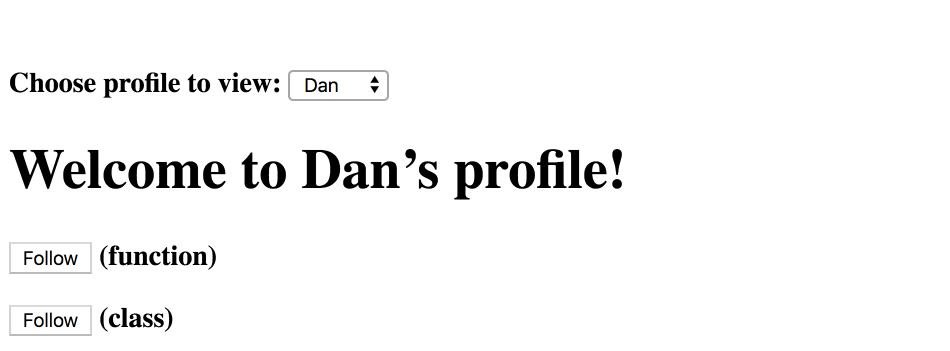为什么要了解 Function 写法的组件呢?因为它正在变得越来越重要。
那么 React 中 Function Component 与 Class Component 有何不同?
how-are-function-components-different-from-classes 这篇文章带来了一个独特的视角。
顺带一提,以后会用 Function Component 代替 Stateless Component 的说法,原因是:自从 Hooks 出现,函数式组件功能在不断丰富,函数式组件不再需要强调其无状态特性,因此叫 Function Component 更为恰当。
原文事先申明:并没有对 Function 与 Classes 进行优劣对比,而仅仅进行特性对比,所以不接受任何吐槽。
这两种写法没有好坏之分,性能差距也几乎可以忽略,而且 React 会长期支持这两种写法。
对比下面两段代码。
Class Component:
class ProfilePage extends React.Component {
showMessage = () => {
alert("Followed " + this.props.user);
};
handleClick = () => {
setTimeout(this.showMessage, 3000);
};
render() {
return <button onClick={this.handleClick}>Follow</button>;
}
}Function Component:
function ProfilePage(props) {
const showMessage = () => {
alert("Followed " + props.user);
};
const handleClick = () => {
setTimeout(showMessage, 3000);
};
return <button onClick={handleClick}>Follow</button>;
}(在线 Demo)
这两个组件都描述了同一个逻辑:点击按钮 3 秒后 alert 父级传入的用户名。
如下父级组件的调用方式:
<ProfilePageFunction user={this.state.user} />
<ProfilePageClass user={this.state.user} />那么当点击按钮后的 3 秒内,父级修改了 this.state.user,弹出的用户名是修改前的还是修改后的呢?
Class Component 展示的是修改后的值:
Function Component 展示的是修改前的值:
那么 React 文档中描述的 props 不是不可变(Immutable) 数据吗?为啥在运行时还会发生变化呢?
原因在于,虽然 props 不可变,是 this 在 Class Component 中是可变的,因此 this.props 的调用会导致每次都访问最新的 props。
而 Function Component 不存在 this.props 的语法,因此 props 总是不可变的。
为了便于理解,笔者补充一些代码注解:
Function Component:
function ProfilePage(props) {
setTimeout(() => {
// 就算父组件 reRender,这里拿到的 props 也是初始的
console.log(props);
}, 3000);
}Class Component:
class ProfilePage extends React.Component {
render() {
setTimeout(() => {
// 如果父组件 reRender,this.props 拿到的永远是最新的。
// 并不是 props 变了,而是 this.props 指向了新的 props,旧的 props 找不到了
console.log(this.props);
}, 3000);
}
}如果希望在 Class Component 捕获瞬时 Props,可以: const props = this.props;,但这样的代码很蹩脚,所以如果希望拿到稳定的 props,使用 Function Component 是更好的选择。
看下面的代码:
function MessageThread() {
const [message, setMessage] = useState("");
const showMessage = () => {
alert("You said: " + message);
};
const handleSendClick = () => {
setTimeout(showMessage, 3000);
};
const handleMessageChange = e => {
setMessage(e.target.value);
};
return (
<>
<input value={message} onChange={handleMessageChange} />
<button onClick={handleSendClick}>Send</button>
</>
);
}(在线 Demo)
在点击 Send 按钮后,再次修改输入框的值,3 秒后的输出依然是 点击前输入框的值。这说明 Hooks 同样具有 capture value 的特性。
利用 useRef 可以规避 capture value 特性:
function MessageThread() {
const latestMessage = useRef("");
const showMessage = () => {
alert("You said: " + latestMessage.current);
};
const handleSendClick = () => {
setTimeout(showMessage, 3000);
};
const handleMessageChange = e => {
latestMessage.current = e.target.value;
};
}只要将赋值与取值的对象变成 useRef,而不是 useState,就可以躲过 capture value 特性,在 3 秒后得到最新的值。
这说明了利用 Function Component + Hooks 可以实现 Class Component 做不到的 capture props、capture value,而且 React 官方也推荐 新的代码使用 Hooks 编写。
原文 how-are-function-components-different-from-classes 从一个侧面讲述了 Function Component 与 Class Component 的不同点,之所以将 Function Component 与 Class Component 相提并论,几乎都要归功于 Hooks API 的出现,有了 Hooks,Function Component 的能力才得以向 Class Component 看齐。
关于 React Hooks,之前的两篇精读分别有过介绍:
但是,虽然 Hook 已经发布了稳定版本,但周边生态跟进还需要时间(比如 useRouter)、最佳实践整理还需要时间,因此不建议重构老代码。
为了更好的使用 Function Component,建议时常与 Class Component 的功能做对比,方便理解和记忆。
下面整理一些常见的 Function Component 问题:
非常建议完整阅读 React Hooks FAQ。
说实话,Function Component 替代 shouldComponentUpdate 的方案并没有 Class Component 优雅,代码是这样的:
const Button = React.memo(props => {
// your component
});或者在父级就直接生成一个自带 memo 的子元素:
function Parent({ a, b }) {
// Only re-rendered if `a` changes:
const child1 = useMemo(() => <Child1 a={a} />, [a]);
// Only re-rendered if `b` changes:
const child2 = useMemo(() => <Child2 b={b} />, [b]);
return (
<>
{child1}
{child2}
</>
);
}相比之下,Class Component 的写法通常是:
class Button extends React.PureComponent {}这样就自带了 shallowEqual 的 shouldComponentUpdate。
由于 useEffect 每次 Render 都会执行,因此需要模拟一个 useUpdate 函数:
const mounting = useRef(true);
useEffect(() => {
if (mounting.current) {
mounting.current = false;
} else {
fn();
}
});更多可以查看 精读《怎么用 React Hooks 造轮子》
React 官方文档提供了一种方案:
const [ignored, forceUpdate] = useReducer(x => x + 1, 0);
function handleClick() {
forceUpdate();
}每次执行 dispatch 时,只要 state 变化就会触发组件更新。当然 useState 也同样可以模拟:
const useUpdate = () => useState(0)[1];我们知道 useState 下标为 1 的项是用来更新数据的,而且就算数据没有变化,调用了也会刷新组件,所以我们可以把返回一个没有修改数值的 setValue,这样它的功能就仅剩下刷新组件了。
更多可以查看 精读《怎么用 React Hooks 造轮子》
useState 目前的一种实践,是将变量名打平,而非像 Class Component 一样写在一个 State 对象里:
class ClassComponent extends React.PureComponent {
state = {
left: 0,
top: 0,
width: 100,
height: 100
};
}
// VS
function FunctionComponent {
const [left,setLeft] = useState(0)
const [top,setTop] = useState(0)
const [width,setWidth] = useState(100)
const [height,setHeight] = useState(100)
}实际上在 Function Component 中也可以聚合管理 State:
function FunctionComponent() {
const [state, setState] = useState({
left: 0,
top: 0,
width: 100,
height: 100
});
}只是更新的时候,不再会自动 merge,而需要使用 ...state 语法:
setState(state => ({ ...state, left: e.pageX, top: e.pageY }));可以看到,更少的黑魔法,更可预期的结果。
虽然不怎么常用,但是毕竟 Class Component 可以通过 componentWillReceiveProps 拿到 previousProps 与 nextProps,对于 Function Component,最好通过自定义 Hooks 方式拿到上一个状态:
function Counter() {
const [count, setCount] = useState(0);
const prevCount = usePrevious(count);
return (
<h1>
Now: {count}, before: {prevCount}
</h1>
);
}
function usePrevious(value) {
const ref = useRef();
useEffect(() => {
ref.current = value;
});
return ref.current;
}通过 useEffect 在组件渲染完毕后再执行的特性,再利用 useRef 的可变特性,让 usePrevious 的返回值是 “上一次” Render 时的。
可见,合理运用 useEffect useRef,可以做许多事情,而且封装成 CustomHook 后使用起来仍然很方便。
未来
usePrevious可能成为官方 Hooks 之一。
useState 函数的参数虽然是初始值,但由于整个函数都是 Render,因此每次初始化都会被调用,如果初始值计算非常消耗时间,建议使用函数传入,这样只会执行一次:
function FunctionComponent(props) {
const [rows, setRows] = useState(() => createRows(props.count));
}
useRef不支持这种特性,需要写一些冗余的函判定是否进行过初始化。
掌握了这些,Function Component 使用起来与 Class Component 就几乎没有差别了!
Function Component 功能已经可以与 Class Component 媲美了,但目前最佳实践比较零散,官方文档推荐的一些解决思路甚至不比社区第三方库的更好,可以预料到,Class Component 的功能会被五花八门的实现出来,那些没有被收纳进官方的 Hooks 乍看上去可能会眼花缭乱。
总之选择了 Function Component 就同时选择了函数式的好与坏。好处是功能强大,几乎可以模拟出任何想要的功能,坏处是由于可以灵活组合,如果自定义 Hooks 命名和实现不够标准,函数与函数之间对接的沟通成本会更大。
如果你想参与讨论,请 点击这里,每周都有新的主题,周末或周一发布。前端精读 - 帮你筛选靠谱的内容。
关注 前端精读微信公众号
special Sponsors
版权声明:自由转载-非商用-非衍生-保持署名(创意共享 3.0 许可证)


